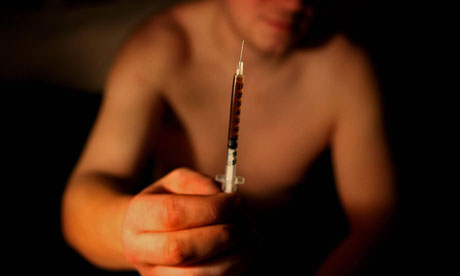overdose cure
 Use ‘overdose cure’ naloxone more widely, drugs advisory council urges
Use ‘overdose cure’ naloxone more widely, drugs advisory council urges
Call for health minister to make potentially lifesaving treatment available without prescription
prompts fears in some quarters that addicts will be tempted into riskier habits
By – Daniel Boffey – The Observer, Saturday 19 May 2012
Photograph: Julien Behal
Critics fear that the more widespread availability of naloxone will end up encouraging heroin use.
An antidote to heroin overdoses should be made widely available without prescription, according to controversial advice from the government’s drugs advisory body.
Critics claim that the distribution of naloxone would create a “safety net” for drug users and potentially encourage greater use of class A drugs.
But the Advisory Council on the Misuse of Drugs (ACMD) has written to health minister Anne Milton to argue that people working with the UK’s estimated 300,000 heroin addicts will be able to save lives if they are given access to the drug.
When a heroin user has an overdose, one injection of naloxone revives them from unconsciousness and gives them enough time for medical help to arrive. It is already used by ambulance crews, casualty staff and out-of-hours GPs.
But the drug is only available on prescription, which means people working with drug users cannot keep stocks or carry them in case of emergency.
The government will be under pressure to ignore the advice, with some claiming naloxone encourages users to indulge in even riskier drug-taking.
Others have warned that up to 3% of those receiving naloxone suffer potentially life-threatening side-effects and even that it can be used as a weapon in fights between users.
However, the chairman of the advisory council, Professor Les Iversen, told Milton: “The ACMD is not aware of any significant body of evidence that naloxone provision encourages increased heroin use.
“The ACMD concludes that naloxone provision is an evidence-based intervention, which can save lives. Naloxone provision fits with other measures to promote recovery by encouraging drug users to engage with treatment services, and, ultimately, keep them alive until they are in recovery.”
Mike Pattinson, a former probation officer and now the director of operations at the Brighton-based health and social care charity CRI, said:
“We know that if people in constant contact with heroin users are able to carry this drug that they will save lives. We would hope that the government acts on this advice because it is compelling.”
Trevor Ball, 40, a recovering heroin addict, said he had been saved by naloxone when paramedics had been called but believed others could have been rescued from overdoses if it had been more widely accessible.
He said: “Drug users don’t think about life and death when they take heroin. It is a case of ‘it will never happen to me’‘, so the idea that access to naloxone will encourage drug use is a nonsense. I have been saved by it and I have seen others go blue, go over, and been saved by it.”
Regulations concerning the distribution of naloxone have already been relaxed in Scotland, where the devolved government is funding the distribution of 10,000 units.
Click Here for guardian.co.uk/politics/2012/may/20/use-overdose-cure-naloxone
